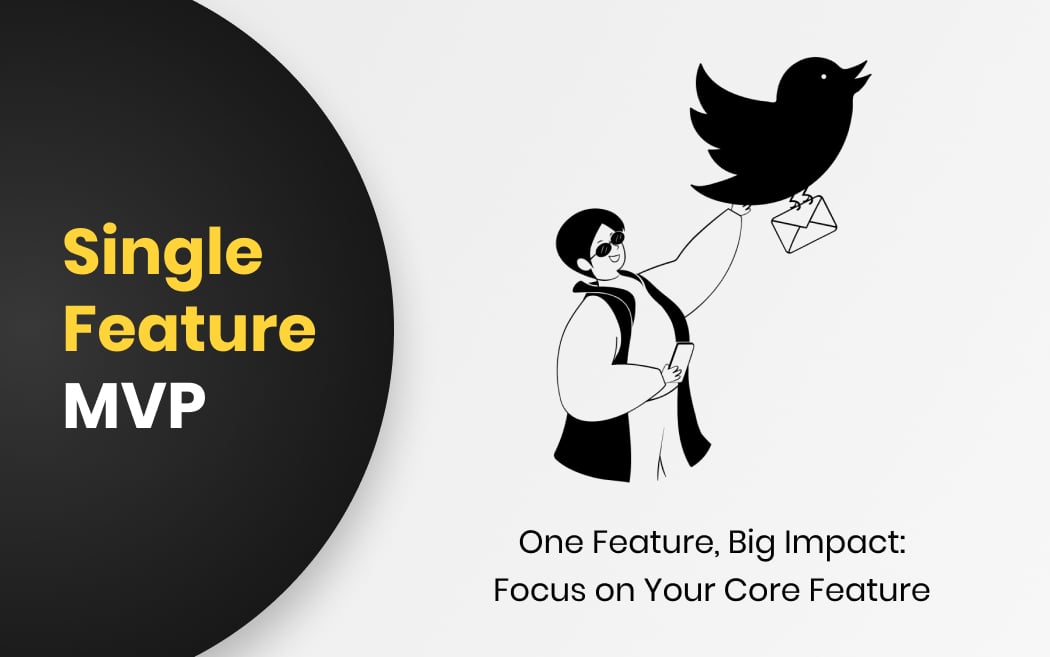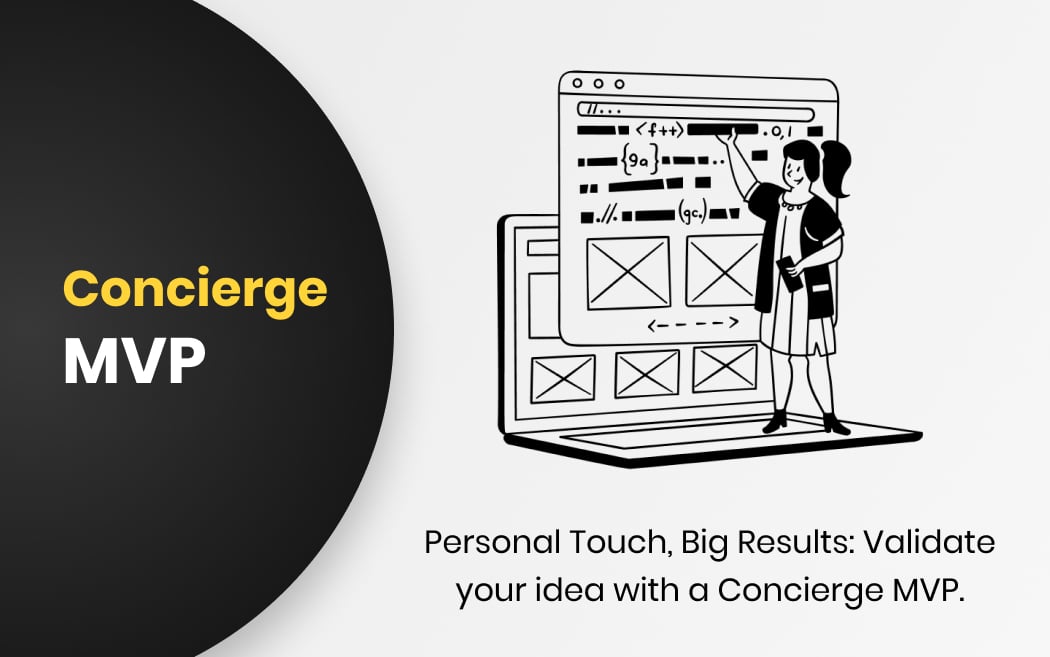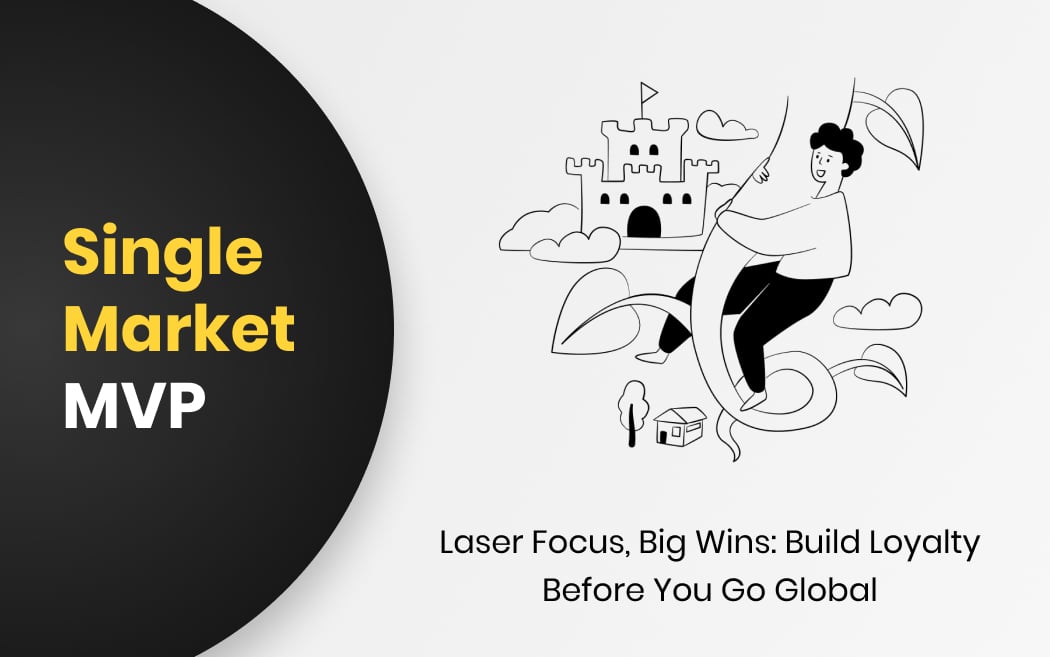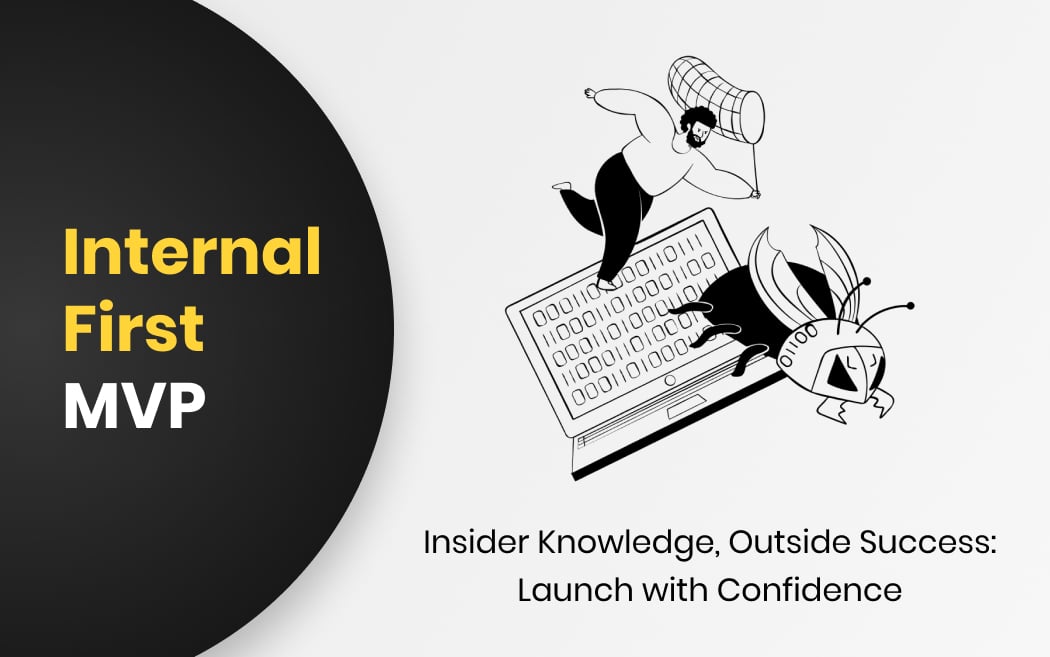Do you have a great product idea for your startup and want to identify whether potential customers will likely adopt it, is the idea worth investing in, what’s the reaction of your target audience when they first interacted with your product, and what they necessarily think about it? Are they interested in using your product or abandoning it from the first use, looking for better alternatives? To get answers to all of these questions, adopting a minimum viable product (MVP) is a way-to-go approach. Want to spill the beans about what an MVP is and why it became a widely adopted approach among entrepreneurs, startups, and small to medium-scale businesses?
Continue reading as we’ve curated this descriptive guide to uncover what a minimum viable product is and the different types of MVPs available that are implemented by industry-leading experts to test their concepts. Furthermore, you’ll find the ten most inspirational minimum viable product examples of different MVPs in this blog post. It will motivate you to kick-start your MVP development journey toward turning your innovative ideas into a tangible product.
Key Takeaways
- An MVP is a simplified product version with only essential features to address the main user problem. It aims to validate the product idea quickly and with minimal resources.
- The benefits of an MVP include saving time and money by focusing on core features, testing and confirming market demand, providing early user insights, and enabling a quicker market entry.
- There are different types of MVPs, including single feature MVP, concierge MVP, piecemeal MVP, single-market MVP, and internal-first MVP.
- The most popular minimum viable product examples, include Pinterest, Instagram, Slack, Groupon, Uber, and Meta. These companies utilized MVP to test their product concept and later on scaled their product after successful product validation.
What is a Minimum Viable Product?

MVP, as the name suggests, is the minimum version of your product launched to the market with enough features to attract early adopters, whereas viable means validating your concept and its acceptance or need in the market. Before transitioning the mini version of your product into a future-ready application, testing it with a core set of features enables you to identify how customers respond to your product, do they find it useful and aligned with their needs, and whether it solves their pain points.
The idea is to start small and further enhance your product based on real-time customer feedback. You take cues from your potential customers to understand to which extent your product solves their problems, needs, and expectations. And then moving accordingly to build a user-centric MVP that meets their needs in the final version. Altogether, this approach helps you validate your MVP based on factual proof of its acceptance rather than building it based on assumptions.
What are the core benefits of building an MVP?
- Lowers development costs by focusing solely on core features development
- Facilities you to launch your MVP with a faster time-to-market to attract early customers and get insights into how they perceive it and what further improvements they’re looking forward to in your product.
- Helps you create user personas to identify their pain points and challenges.
- Enables you to gain investor's interest in your concept through concept validation.
- Constantly revolves around gaining customer feedback to inform decision-making and further enhancements.
- Reduces the risk of failure by validating assumptions and testing the market demand before investing significant resources into the full product development.
*Read on: Explore 10 Effective tips for your MVP development that help you streamline your development process and launch your new product successfully to the market.*
*Also Learn: Discover what’s the major difference between POC, prototype, and MVP.*
Comprehensive Guide: Types of Minimum Viable Products and Their Examples
Once you’ve got a brief idea about what an MVP is, the next step is to select the type of MVP you want to build for your product. A minimum viable product is further divided into different categories; you need to select the one that aligns with your business needs and objectives. Below we’ll be discussing different types of MVPs. Further, you’ll discover the relevant minimum viable product examples associated with different MVPs:
1. Single Feature MVP

A single-feature MVP focuses on developing and launching a product with a single feature or a small set of features. This approach allows you to stay focused on solving the specific problem your target audience faces by listing down only the core features. At this point, you need to cut down on other potential features and carefully select the core features that help you achieve your goal.
This method is particularly useful for startups and small teams who want to attract early customers with lower development costs. If the core feature of your MVP resonates with your target audience, you can further add features based on their feedback and usage patterns.
Here are some points that you need to consider when you opt for this MVP category:
- What is the major problem your target audience experiences and how using your product will help them solve it?
- What core feature or set of features will help you solve the major problem effectively?
- Will you be able to test the market viability of your product using the core features?
Pros of Single Feature MVP
- Cost efficiency
- Faster time to market
- Focused user feedback
- Easier to iterate and improve
Cons of Single Feature MVP
- Limited functionality
- May not fully address user needs
- Risk of underwhelming initial users
- Potentially lower market impact
- Might require frequent updates to stay competitive
Single Feature Minimum Viable Product Examples
Let’s discover the two most popular single-feature minimum viable product examples:
Pinterest started as a simple platform for users to create and share visual bookmarks. The core feature was allowing users to "pin" images to boards. This straightforward functionality helped Pinterest validate the demand for a visual discovery tool, enabling users to organize and share their inspirations easily. The simplicity of the initial product allowed the team to focus on user engagement and community growth before expanding its feature set.
One of the well-renowned social media apps, Instagram, falls under the single-feature minimum viable product examples. Instagram today has millions of active users with a lot of features, including adding stories, creating and sharing reels, live broadcasting, and more. But later back, this app was as simple as just uploading pictures, adding filters, and sharing them with friends. This is where Instagram utilized the single-feature MVP by testing it with a core set of features. Instagram quickly gained popularity, validating the market need for such a service by initially launching the app with a core set of features.
2. Concierge MVP

A concierge MVP involves providing a high-touch, manual service to validate a product idea before automating it. Instead of building a complete product, you offer the service manually to a small group of customers to understand their needs and preferences better, leading to user-centric MVP development. Additionally, you can learn from real interactions without significant upfront investment in technology using the concierge MVP.
The main benefit of concierge MVP is that allowing for adjustments before investing in extensive automation to ensure the final product is tailored to meet user needs and expectations. Concierge MVPs are particularly useful for service-oriented businesses where understanding customer requirements deeply is crucial for success.
When to consider Concierge MVP?
- If you want to launch your product faster to the market to test its core concept, rather than investing in developing a complex product, concierge MVP is your choice.
- When you want to offer personalized solutions custom-fit to your user needs.
- When you want to build something complex that requires years to develop.
What to consider for Concierge MVP?
- How easy or difficult it would be for you to staff real people to sell your product, fulfill user needs, and get real user feedback? Are there any special skills and expertise required?
- How much will be the cost difference if you staff people for concierge MVP or proceed to develop the full software solution?
Pros of Concierge MVP
- Deep understanding of user needs
- Personalized customer experience
- Minimal upfront investment
- Quick validation of product concept
Cons of Concierge MVP
- Labor-intensive and time-consuming
- Not easily scalable
- Higher operational costs
- Dependency on manual processes
Concierge Minimum Viable Product Examples
Below, we’ve outlined the two most popular platforms that serve as great examples of concierge MVPs.
Wealthfront
The first most popular concierge minimum viable product example is Wealthfront- an automated investment service. The founder of this platform leveraged concierge MVP at the start to manually manage the investment portfolios of a few clients. This hands-on practice allowed Wealthfront to understand customer needs, preferences, and behaviors deeply. The Insights gained were instrumental in developing the algorithms and automation that form the backbone of Wealthfront's service today. This initial manual effort validated the concept and provided a solid foundation for scaling the business.
Aardvark
Aardvark, a social search engine acquired by Google, began as a concierge MVP by manually matching users' questions with answers from their social network. The Aardvark team personally handled the question-and-answer process, learning about the types of questions people asked and the best ways to find relevant answers. This manual technique helped refine the matching process and validate the demand for a social search engine, leading to the development of the automated system.
3. Piecemeal MVP

A piecemeal MVP leverages existing tools and services to create a functioning prototype of your product. Instead of building everything from scratch, you utilize the already existing third-party tools to deliver your own MVP. Pairing up and connecting different pieces to build your MVP is a lot easier than starting everything from scratch, which ultimately helps you faster market your product. This approach is cost-effective and quick, allowing you to test your idea with minimal investment. By using established tools, you can focus on the unique aspects of your product and validate the concept with real users.
Here, the point to be noted is that this model isn’t suitable for every business as it contains a risk in building something that you can’t use easily to build the final product. You need to thoughtfully research if a piecemeal MVP is your go-to approach because if you're launching your initial MVP and later building it from scratch, you may not find this method worthwhile. On the other hand, if the cost to build the MVP is relatively low, it may still be worth considering.
When do you consider building a Piecemeal MVP?
- In case you have limited financial resources and need to minimize initial development costs.
- Your team lacks the technical expertise to build a complex solution from scratch and needs to leverage existing tools and services.
- When entering a highly competitive market where speed is crucial, you need to validate your idea rapidly with minimal investment.
It is recommended to consult a leading software development company if you choose a piecemeal MVP. This will allow you to compare the actual cost of developing a traditional MVP versus a piecemeal MVP.
Pros of Piecemeal MVP
- Cost-effective development
- Rapid market entry
- Utilizes existing tools and technologies
- Allows focus on core functionality
Cons of Piecemeal MVP
- Limited scalability
- Dependency on third-party tools
- Potential integration issues
- Less control over the final product
Piecemeal Minimum Viable Product Example
Check out the examples of Piecemeal MVP in the section below:
Groupon
Groupon is amongst the top minimum viable product examples using Piecemeal MVP. It uses a simple WordPress blog and manually creates PDF coupons to send to customers. They leveraged email to communicate deals and used basic tools to track customer purchases. Groupon was able to validate the concept of group buying and discount deals without developing a complex platform. The success of this MVP confirmed the demand, leading to the development of a more sophisticated system that automated the deal distribution and redemption process.
Foursquare
Foursquare is one of the famous minimum viable product examples that leveraged existing location-based services and social networking platforms in their piecemeal MVP app design. Initially, users could "check-in" to venues using the Foursquare app, earning points and badges for their activities. The app utilized GPS technology available on smartphones to track users' locations. Foursquare initially relied on users to manually input venue information and reviews. This piecemeal approach allowed Foursquare to quickly test the concept of location-based social networking and gather user feedback before investing in more advanced features and backend infrastructure.
4. Single-market MVP

If you want to target a specific market or a customer segment, then single-market MVP is the best option to consider. Single-market MVP enables you to test your product idea by focusing on a niche-specific audience. With the development of a single-market MVP, you can tailor your MVP to meet the specific needs and preferences of the customer segment you want to target.
This allows you to gain traction in a smaller market before expanding to a broader audience. Moreover, it helps in building a strong foundation and loyal customer base, which can be crucial for scaling your MVP successfully. Further, testing in a single market also provides valuable insights and feedback that can inform product improvements and future market expansions.
What questions do you need to consider when building your single-market MVP?
- What specific target group, market segment, or use base do you want to target to build your MVP?
- What unique value does your product offer to this market, including the unique selling points and benefits of your product that differentiate it from competitors?
- What are the key challenges and needs of the specific market or customer segment that you’re trying to target?
Pros of Single-market MVP
- Focused targeting and tailored product development
- Easier to gather specific and relevant user feedback
- Lower initial marketing and distribution costs
- Builds a strong, loyal customer base in a niche market
Cons of Single-market MVP
- Limited market reach and growth potential
- Risk of misjudging the target market's needs
- Potential challenges in scaling to other markets
- Dependence on the success of a single market segment
Single-Market Minimum Viable Product Examples
Look into the inspirational minimum viable product examples of this model and test it yourself.
Facebook (Meta)
Facebook initially launched as a social networking site exclusively for Harvard University students. This single-market approach allowed Facebook to refine its product, focusing on the specific needs of college students. The closed environment provided valuable feedback and helped build a strong user base before expanding to other universities and eventually the general public. The success in this niche market validated the concept and set the stage for rapid growth and broader adoption.
Uber
Uber back in 2009 started as an MVP when its founders wanted to test their ride-hailing service idea. They began by targeting the service only for San Francisco residents which is far below the markets that Uber serves today. The main idea was to target a specific market- which is more tech-savvy and open to new technologies than other parts of the country to test the viability of the product and that’s too with the focus on only one main feature- booking a ride. The feedback and data collected from this initial market helped Uber improve its service and operational model, which facilitated its expansion to other cities and countries.
5. Internal-first MVP

An Internal-first MVP is developed and tested within the organization before being released to external users. This approach allows you to gather feedback from employees, refine the product, and ensure it meets the necessary standards before a public launch. Internal testing helps identify bugs and fix issues early, ensuring a smoother rollout to the market.
It also allows employees to become familiar with the product, making them better advocates and supporters once it is publicly released. This method is particularly useful for complex products or those requiring significant user training.
What questions do you need to consider when building your internal-first MVP
- What resources and support will our internal team need to successfully implement and use the MVP?
- How will we document and manage internal feedback for iterative improvements?
- How to mitigate potential challenges that might arise during internal testing?
- What metrics and feedback mechanisms will we use to evaluate the MVP’s effectiveness internally?
Pros of Internal-first MVP
- Immediate and direct access to feedback
- Controlled testing environment
- Early identification and resolution of issues
- Increased team familiarity and advocacy for the product
Cons of Internal-first MVP
- Limited diversity in feedback
- Potential bias from internal testers
- Risk in creating a product unsuitable for an external audience
Internal-first Minimum Viable Product Examples
Let’s dive into exploring the internal-first minimum viable product examples:
Slack
Slack began as an internal tool the company's team uses to improve communication and collaboration. By testing the product internally, Slack could refine its features, fix bugs, and optimize the user experience based on real-world usage. This internal-first approach ensured that Slack was well-polished and effective by the time it was released to the public, contributing to its rapid adoption and success.
Twitter, now rebranded as "X," was initially used internally by the employees of Odeo, the podcasting company where it was developed. This internal testing phase allowed the team to experiment with the concept of short status updates and refine the product based on their own experiences and feedback. The internal-first approach helped develop a robust and engaging platform, setting the stage for its public launch and subsequent growth in the social media era.
Conclusion
Implementing an idea without validating the concept, not identifying the product-market fit, and incorporating the bulk of features upfront isn’t a good approach and ultimately leads to product failure. However, to overcome this issue, the best way is to adopt the MVP-first approach that helps you to identify if your idea is feasible and has enough potential need or demand in the market. Moreover, you’ll be able to gauge your target audience feedback after you release your MVP in the market with a core set of features.
Ultimately you build MVP, measure its effectiveness, learn from the mistakes, and iterate based on that to ensure the final product provides great value to the customer. Overall, in this blog post, we’ve covered different types of MVPs, including single feature MVP, concierge MVP, piecemeal MVP, single-market MVP, and internal-first MVP that you can implement as per your business objectives. Additionally, the minimum viable product examples covered for each MVP show how companies implemented the MVP concept in their product development process to ensure its success. Go ahead and embrace MVP by taking some inspiration from these minimum viable product examples!











